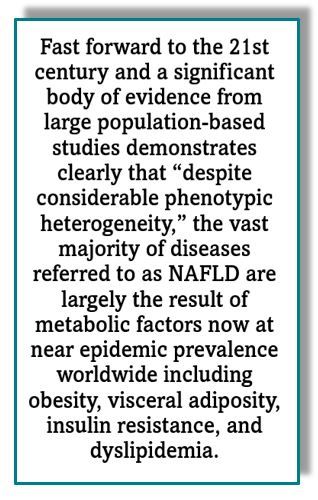- CDC
- Heart Failure
- Cardiovascular Clinical Consult
- Adult Immunization
- Hepatic Disease
- Rare Disorders
- Pediatric Immunization
- Implementing The Topcon Ocular Telehealth Platform
- Weight Management
- Monkeypox
- Guidelines
- Men's Health
- Psychiatry
- Allergy
- Nutrition
- Women's Health
- Cardiology
- Substance Use
- Pediatrics
- Kidney Disease
- Genetics
- Complimentary & Alternative Medicine
- Dermatology
- Endocrinology
- Oral Medicine
- Otorhinolaryngologic Diseases
- Pain
- Gastrointestinal Disorders
- Geriatrics
- Infection
- Musculoskeletal Disorders
- Obesity
- Rheumatology
- Technology
- Cancer
- Nephrology
- Anemia
- Neurology
- Pulmonology
It's High Time to Retire NAFLD: Multinational Liver Societies Explain
NAFLD, a term coined in the mid-nineteenth century but never an accurate name for the diseases it now stands for, was ready to go, agreed international experts.
Steatotic liver disease (SLD) was chosen by a multinational group of liver societies in June 2023 as an overarching term that better indicates the multifactorial pathophysiology underlying the hepatic disease than the narrow and potentially shaming term "fatty liver disease." The term "nonalcoholic" was also retired in favor of "metabolic dysfunction-associated" to account for the variety of causes for fat deposition in the liver outside of excess alcohol consumption. The result: metabolic dysfunction-associated steatotic liver disease (MASLD) is proposed as a replacement for nonalcoholic fatty liver disease (NAFLD).
The process to revise the nomenclature used to define the various etiologies of hepatic steatosis began in 2020 with participation by 225 global hepatology and gastroenterology societies, patients and patient advocacy organizations, regulatory experts, and industry representatives. The original gathering was to determine if, in fact, a new nomenclature was needed—and if so, to determine, and agree upon, the best terms.
"Overfed children"
The change in nomenclature was long overdue, according to a multinational liver society statement. There were many reasons for this but principal among them was the longstanding effort to revise an original description that dates to 1849 of “visceral and subcutaneous adiposity in overfed children.” For lack of a more nuanced understanding of the pathophysiology of the disease the term nonalcoholic fatty liver disease (NAFLD) was adopted because it telegraphed the presence of liver fat but excluded excess alcohol, one of the most common causes known for hepatic steatosis at the time.

Fast forward to the 21st century and a significant body of evidence from large population-based studies demonstrates clearly that “despite considerable phenotypic heterogeneity,” the vast majority of diseases referred to as NAFLD are largely the result of metabolic factors now at near epidemic prevalence worldwide including obesity, visceral adiposity, insulin resistance, and dyslipidemia.
Inherently flawed description
Authors describe a number of flaws inherent in the notion of NAFLD, the first being its description of what doesn’t cause the disease vs what does. Secondly, there was consensus among the committee participants around the term “fatty” as laden with stigma, which may hinder awareness of the disease and, more importantly, create a barrier to individuals accessing health care. There is also the very significant problem that NAFLD does not account for and cannot be used to identify a common clinical scenario in which liver fat is the result of both metabolic- and alcohol-related factors. The result is often the labeling of persons whose alcohol consumption is minimal and by definition “nonrisky” as having alcohol-only hepatic disease. In addition to the associated stigma of the label, the term most likely leads to underestimation of the role of metabolic syndrome in etiology of liver disease, with further implications for insurance and other health benefits.
NAFLD as a descriptor may also hinder optimal research into the role of each factor in disease presentation as well as their synergies in persons with both alcohol- and metabolic-related dysfunction. Further, other chronic liver diseases, for example viral or autoimmune, may be comorbid with metabolic risk factors and contribute to the overall burden of liver injury.
Results
The Delphi methodology employed in the nomenclature change effort yielded a final response rate of 75%, characterized as a strong outcome “given the large sample size involved in 4 rounds of data collection. The resulting terminology:
- Metabolic dysfunction-associated steatotic liver disease (MASLD) encompasses individuals with hepatic steatosis and at least 1 of 5 core cardiometabolic risk factors.
- Metabolic dysfunction-associated steatohepatitis (MASH) is the replacement term for nonalcoholic steatohepatitis (NASH).
- Outside of pure MASLD, a new category termed MetALD describes those with MASLD who consume greater amounts of alcohol per week (140 g/week and 210 g/week for women and men, respectively).
- Individuals who have no metabolic parameters and no other know cause for hepatic disease have cryptogenic SLD.
For additional information, please visit the American Association for the Study of Liver Disease - New MASLD nomenclature.
